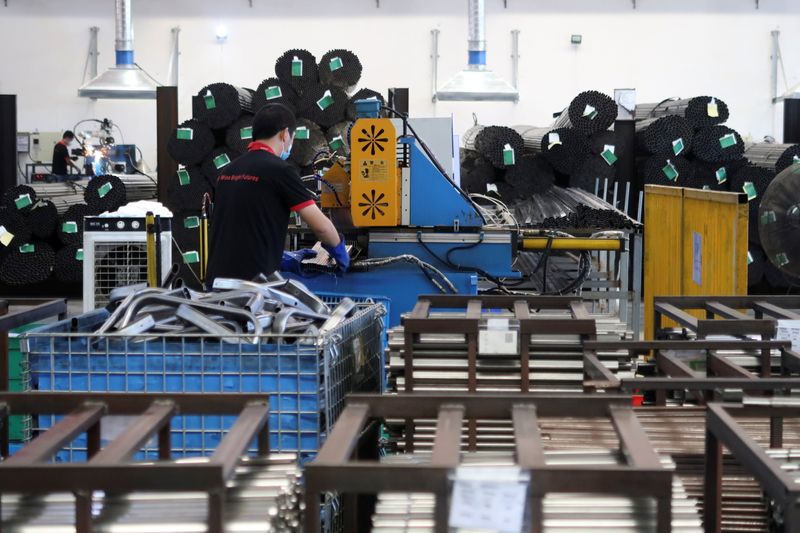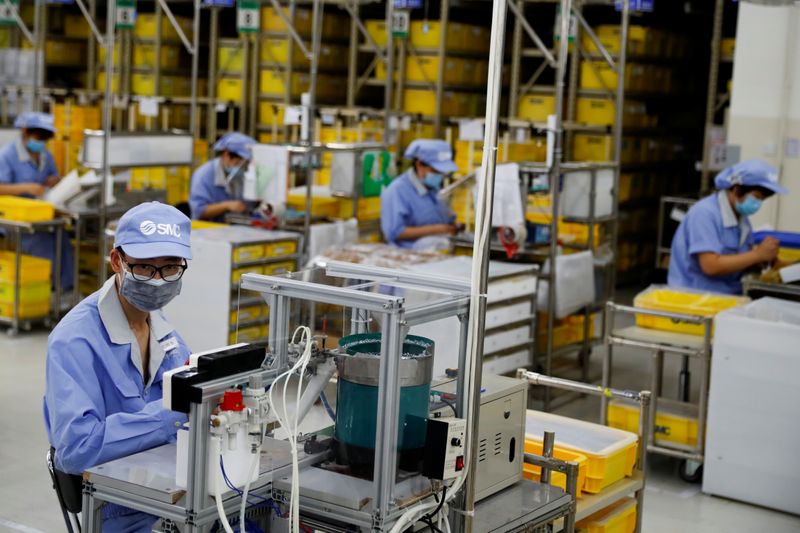
FILE PHOTO: Employees work on the production line of American infant product and toy manufacturer Kids II Inc. at a factory in Jiujiang, Jiangxi province, China June 22, 2021. REUTERS/Gabriel Crossley
September 30, 2021
BEIJING (Reuters) -China’s factory activity unexpectedly shrank in September as high raw material prices and power cuts pressured manufacturers in the world’s second-largest economy, while the services sector returned to expansion as COVID-19 outbreaks receded.
The official manufacturing Purchasing Manager’s Index (PMI) was at 49.6 in September versus 50.1 in August, data from the National Bureau of Statistics (NBS) showed on Thursday, slipping into contraction for the first time since February 2020.
Analysts in a Reuters poll had expected the index to remain steady at 50.1, unchanged from the previous month. The 50-point mark separates growth from contraction.
China’s economy rapidly recovered from a pandemic-induced slump last year, but momentum has weakened in recent months, with its sprawling manufacturing sector hit by rising costs, production bottlenecks and more recently electricity rationing.
Reflecting the production pressures, a sub-index for factory output contracted in September for the first time since February last year, and stood at 49.6 versus 50.1 a month earlier.
“In September, due to factors such as low volumes of business at high energy-consuming industries, the manufacturing PMI fell below the critical point,” said Zhao Qinghe, a senior NBS statistician, in an accompanying statement.
“The two indexes of high energy-consuming industries such as petroleum, coal and other fuel processing, chemical fibre and rubber and plastic products, ferrous metal smelting and rolling processing are both lower than 45.0, indicating a significant drop in supply and demand.”
A shortage of coal, tougher emissions standards and strong demand from manufacturers and industry pushed coal prices to record highs and triggered widespread curbs on electricity usage in at least 20 provinces and regions.
Higher raw material prices, especially of metals and semiconductors, have also pressured profits of manufacturers. Earnings at China’s industrial firms in August slowed for the sixth straight month.
A sub-index for raw material costs rose to 63.5 in September from 61.3 a month earlier, while a gauge of new orders came in at 49.3 compared with 49.6 in August, shrinking for the second straight month.
A sub-index for employment remained in contraction, at 47.8 versus 47.0 a month earlier.
On a more sanguine note, the official non-manufacturing PMI in September was at 53.2, bouncing back from 47.5 in August, data from the NBS showed, as COVID-19 outbreaks receded after rising during the summer months.
COVID-19 cases were reported in tens of cities over summer in the most serious outbreak since earlier in January, disrupting activity in both the services and manufacturing sectors, particularly small businesses and factories.
Last month, COVID-19-related restrictions drove services sector activity into sharp contraction for the first time since the height of the pandemic last year.
The official September composite PMI, which includes both manufacturing and services activity, stood at 51.7 versus 48.9 in August.
(Reporting by Ryan Woo and Gabriel Crossley; Editing by Tom Hogue and Ana Nicolaci da Costa)

